Experimental Study on Uniaxial Compression Mechanics and Failure Characteristics of Non-Through Fractured Rock
Abstract
:1. Introduction
2. Theoretical Model
3. Test Scheme
3.1. Specimen Preparation
3.2. Experimental Device and Method
4. Mechanical Properties of White Sandstone Specimens
4.1. Peak Stress Characteristics of Rock Specimens
4.2. Damage Characteristics of Rock Specimens
4.3. Analysis of Failure Evolution Process of Rock Specimens
4.4. AE Characteristics
4.5. Mechanism of 3D Crack Growth
5. Engineering Significance
6. Conclusions
- (1)
- According to the failure mechanism of the three-dimensional failure model of the surface-damaged specimen, the surface crack specimen was divided into a damaged rock specimen and an undamaged rock specimen, and a three-dimensional mechanical model of the surface crack specimen based on the COFPDP theory was established. The failure mechanisms of fracture fronts A, B, and C in the damaged rock specimen were analyzed. In the uniaxial experiment, the initiation mode and propagation mechanism of the fracture front of the surface horizontally fractured rock specimens were related to the lengths of the A and B fracture fronts.
- (2)
- Through comparative analysis of six kinds of specimens, it was concluded that the complete specimen was an overall failure, that the failure of the surface crack specimen was jointly guided by the surface crack and the complete part of the rock specimen, and that the failure of the penetrating crack specimen was controlled by the penetrating crack. The different failure modes of the three types of rock specimens led to very large differences in the whole failure process, which were mainly reflected in the structural stability and residual strength of the post-peak failure rock specimens. At the same time, the appearance of three-dimensional curved fissures confirmed the necessity of introducing the COFPDP theory of three-dimensional fissure extension.
- (3)
- The surface-fractured rock specimen presented the propagation form of a tip crack, which is different from a penetrating crack. In the surface-fractured rock specimen, the crack tip was bidirectionally expanded in the upper and lower directions, while the crack tip in the through-crack specimen was unidirectionally expanded. The failure mode was caused by the support and failure lag of the intact rock specimen in the corresponding region of surface fracture.
- (4)
- With an increase in the crack depth of the rock specimen, the failure mode of the specimen transitioned from tensile failure to shear failure. The failure modes were as follows: The complete standard specimen had tensile failure. The surface-fractured rock specimen with a fracture depth of 10 mm had mainly tensile failure, and local shear failure occurred. The surface-fractured rock specimen with a fracture depth of 20 mm had tensile–shear failure, and the fracture surface of the specimen was an X-type failure crack. The surface-fractured rock specimen with a fracture depth of 30 mm had tensile–shear failure; the shear cracks generated in the fracture zone of the specimen and the tensile cracks generated in the complete zone could cause the integrity of the specimen. The failure modes of the surface-fractured rock specimen with a crack depth of 40 mm and the penetrating fractured rock specimen with a crack depth of 50 mm both had shear failure dominated by cracks.
Author Contributions
Funding
Data Availability Statement
Conflicts of Interest
References
- Qian, Q. New progress of rock engineering technology in China. Strateg. Study CAE 2010, 12, 37–48. [Google Scholar]
- She, S.; Lin, P. Some developments and challenging issues in Rock engineering field in China. Chin. J. Rock Mech. Eng. 2014, 33, 433–457. [Google Scholar]
- Fan, H.; Lu, Y.; Hu, Y.; Fang, J.; Lv, C.; Xu, C.; Feng, X.; Liu, Y. A Landslide Susceptibility Evaluation of Highway Disasters Based on the Frequency Ratio Coupling Model. Sustainability 2022, 14, 7740. [Google Scholar] [CrossRef]
- Zhu, C.; Long, S.; Zhang, J.; Wu, W.; Zhang, L. Time Series Multi-Sensors of Interferometry Synthetic Aperture Radar for Monitoring Ground Deformation. Front. Environ. Sci. 2022, 10, 952. [Google Scholar] [CrossRef]
- Cheng, J.; Wang, B.; Fan, T.; Wang, Y.; Jiang, B. Typical application scenes and key technologies of coal mine geolog-ical transparency. Coal Sci. Technol. 2022, 50, 1–12. [Google Scholar]
- Yuan, Z.; Zhao, J.; Li, S.; Jiang, Z.; Huang, F. A Unified Solution for Surrounding Rock of Roadway Considering Seepage, Dilatancy, Strain-Softening and Intermediate Principal Stress. Sustainability 2022, 14, 8099. [Google Scholar] [CrossRef]
- Wu, H.; Jia, Q.; Wang, W.; Zhang, N.; Zhao, Y. Experimental Test on Nonuniform Deformation in the Tilted Strata of a Deep Coal Mine. Sustainability 2021, 13, 13280. [Google Scholar] [CrossRef]
- Li, J.; Yuan, W.; Li, H.; Zou, C. Study on dynamic shear deformation behaviors and test methodology of sawtooth-shaped rock joints under impact load. Int. J. Rock Mech. Min. Sci. 2022, 158, 105210. [Google Scholar] [CrossRef]
- Yu, W.; Wu, G.; An, B.; Wang, P. Experimental Study on the Brittle-Ductile Response of a Heterogeneous Soft Coal Rock Mass under Multifactor Coupling. Geofluids 2019, 2019, 5316149. [Google Scholar] [CrossRef]
- Yu, W.; Li, K. Deformation Mechanism and Control Technology of Surrounding Rock in the Deep-Buried Large-Span Chamber. Geofluids 2020, 2020, 8881319. [Google Scholar] [CrossRef]
- Yang, X.X.; Sun, D.K.; Jing, H.W. Morphological features of shear-formed fractures developed in a rock bridge. Eng. Geol. 2020, 278, 105833. [Google Scholar] [CrossRef]
- Yang, S.; Dai, Y.; Han, L.; He, Y.; Li, Y. Uniaxial compression experimental research on deformation and failure properties of brittle marble deformation and failure properties of brittle marble. Chin. J. Rock Mech. Eng. 2009, 28, 2391–2404. [Google Scholar]
- Yang, S.Q.; Liu, X.R. Experimental investigation on dilatancy behavior of marble with pre-existing fissures under different confining pressures. Chin. J. Geotech. Eng. 2012, 34, 2188–2197. [Google Scholar]
- Zhao, Y.; Zhang, L.; Asce, F.; Wang, W.; Cheng, G. Experimental Study on Shear Behavior and a Revised Shear Strength Model for Infilled Rock Joints. Int. J. Geomech. 2020, 20, 04020141. [Google Scholar] [CrossRef]
- Zhao, Y.; Zhang, L.; Asce, F.; Liao, J.; Tang, L. Experimental Study of Fracture Toughness and Subcritical Crack Growth of Three Rocks under Different Environments. Int. J. Geomech. 2020, 20, 04020128. [Google Scholar] [CrossRef]
- Liu, X.-R.; Yang, S.-Q.; Huang, Y.-H.; Cheng, J.-L. Experimental study on the strength and fracture mechanism of sandstone containing elliptical holes and fissures under uniaxial compression. Eng. Fract. Mech. 2019, 205, 205–217. [Google Scholar] [CrossRef]
- Yu, W.; Wu, G.; Pan, B.; Wang, C.; Li, K.; Liao, Z. Laboratory and field investigations of different bolting configurations for coal mine roadways in weak coal strata. Bull. Eng. Geol. Environ. 2021, 80, 8995–9013. [Google Scholar] [CrossRef]
- Yu, W.; Wu, G.; Pan, B.; Wu, Q.; Liao, Z. Experimental Investigation of the Mechanical Properties of Sandstone-Coal-Bolt Specimens with Different Angles under Conventional Triaxial Compression. Int. J. Geomech. 2021, 21, 04021067. [Google Scholar] [CrossRef]
- Yu, W.; Li, K.; Liu, Z.; An, B.; Wang, P.; Wu, H. Mechanical characteristics and deformation control of surrounding rock in weakly cemented siltstone. Environ. Earth Sci. 2021, 80, 337. [Google Scholar] [CrossRef]
- Zhao, Y.; Tang, J.; Chen, Y.; Zhang, L.; Wang, W.; Wan, W.; Liao, J. Hydromechanical coupling tests for mechanical and permeability characteristics of fractured limestone in complete stress–strain process. Environ. Earth Sci. 2017, 76, 24. [Google Scholar] [CrossRef]
- Zhao, Y.; Zhang, C.; Wang, Y.; Lin, H. Shear-related roughness classification and strength model of natural rock joint based on fuzzy comprehensive evaluation. Int. J. Rock Mech. Min. Sci. 2020, 137, 104550. [Google Scholar] [CrossRef]
- Chen, W.; Wan, W.; Zhao, Y.; Peng, W. Experimental Study of the Crack Predominance of Rock-Like Material Containing Parallel Double Fissures under Uniaxial Compression. Sustainability 2020, 12, 5188. [Google Scholar] [CrossRef]
- Zhu, J.-W.; Cao, W.-S.; Xue, G.-H.; Xue, W.-J.; Zhou, K. Experimental study and numerical simulation of propagation and coalescence-process of a single three dimensional flaw in rocks. J. China Coal Soc. 2013, 38, 411–417. [Google Scholar]
- Fu, J.W.; Chen, K.; Zhu, W.S.; Zhang, X.Z.; Li, X.J. Progressive failure of new modelling material with a single internal crack under biaxial compression and the 3-D numerical simulation. Eng. Fract. Mech. 2016, 165, 140–152. [Google Scholar] [CrossRef]
- Li, S.; Li, T.; Wang, G.; Bai, S. CT real-time scanning tests on rock specimens with artificial initial crack under uniaxial conditions. Chin. J. Rock Mech. Eng. 2007, 26, 484–492. [Google Scholar]
- Ju, Y.; Xie, H.; Zheng, Z.; Lu, J.; Mao, L.; Gao, F.; Peng, R. Visualization of the complex structure and stress field inside rock by means of 3D printing technology. Chin. Sci. Bull. 2014, 59, 5354–5365. [Google Scholar] [CrossRef]
- Ju, Y.; Liu, P.; Ren, Z.; Mao, L.; Chiang, F.P. Characterization of stress field evolution during 3D internal fracture propagation using additively printed models and frozen stress techniques. Theor. Appl. Fract. Mech. 2021, 111, 102870. [Google Scholar] [CrossRef]
- Zhu, J.; Zhou, T.; Liao, Z.; Sun, L.; Li, X.; Chen, R. Replication of internal defects and investigation of mechanical and fracture behaviour of rock using 3D printing and 3D numerical methods in combination with X-ray computerized tomography. Int. J. Rock Mech. Min. Sci. 2018, 106, 198–212. [Google Scholar] [CrossRef]
- Zhou, T.; Zhu, J.B. Identification of a Suitable 3D Printing Material for Mimicking Brittle and Hard Rocks and Its Brittleness Enhancements. Rock Mech. Rock Eng. 2017, 51, 765–777. [Google Scholar] [CrossRef]
- Li, S. Fracture Mechanics; Science Press: Beijing, China, 2015; pp. 278–313. [Google Scholar]
- ASTM D7012; Standard Test Methods for Compressive Strength and Elastic Moduli of Intact Rock Core Specimens under Varying States of Stress and Temperatures. American Society for Testing and Materials: Philadelphia, PA, USA, 2017.
- Chao, Z.; Yun, B. Establishment and application of parametric geometrical damage model of rocks. Rock Soil Mech. 2020, 41, 3899–3909. [Google Scholar]
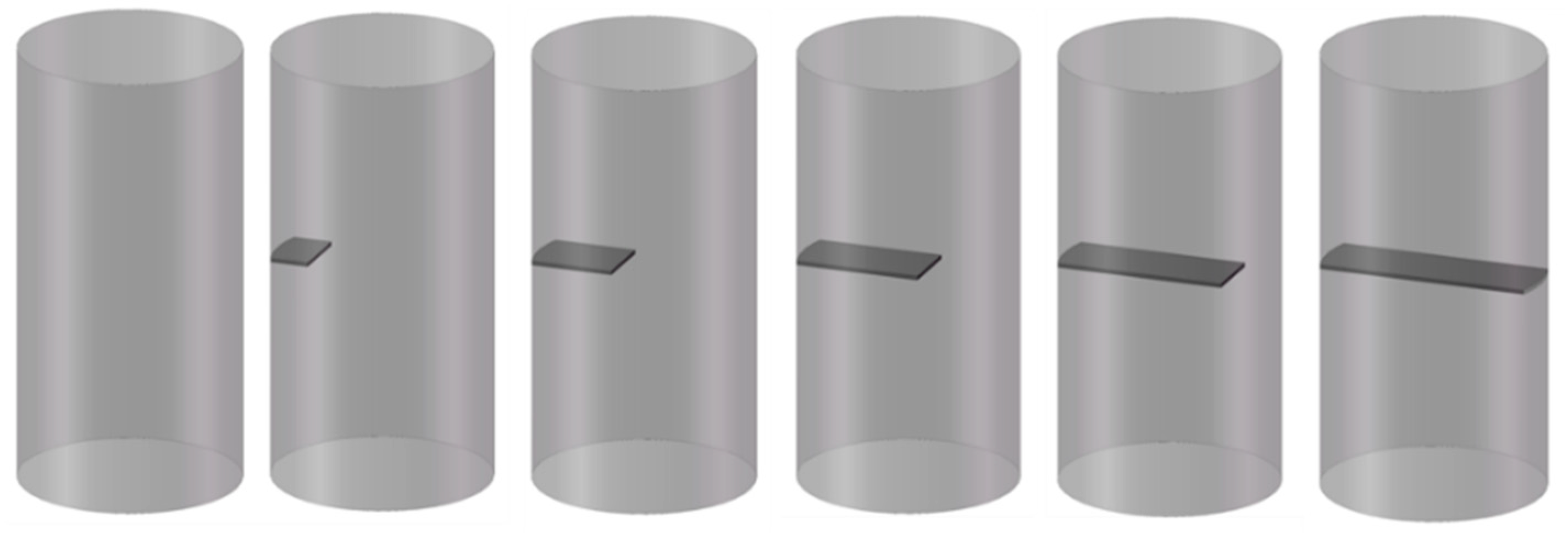


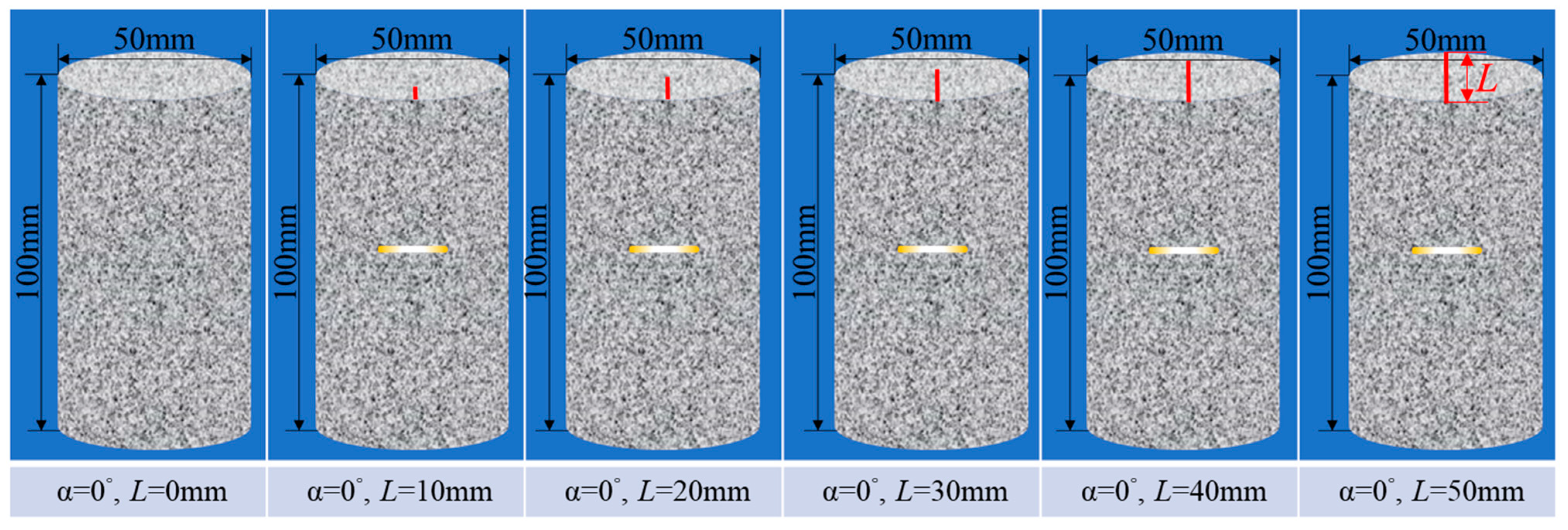
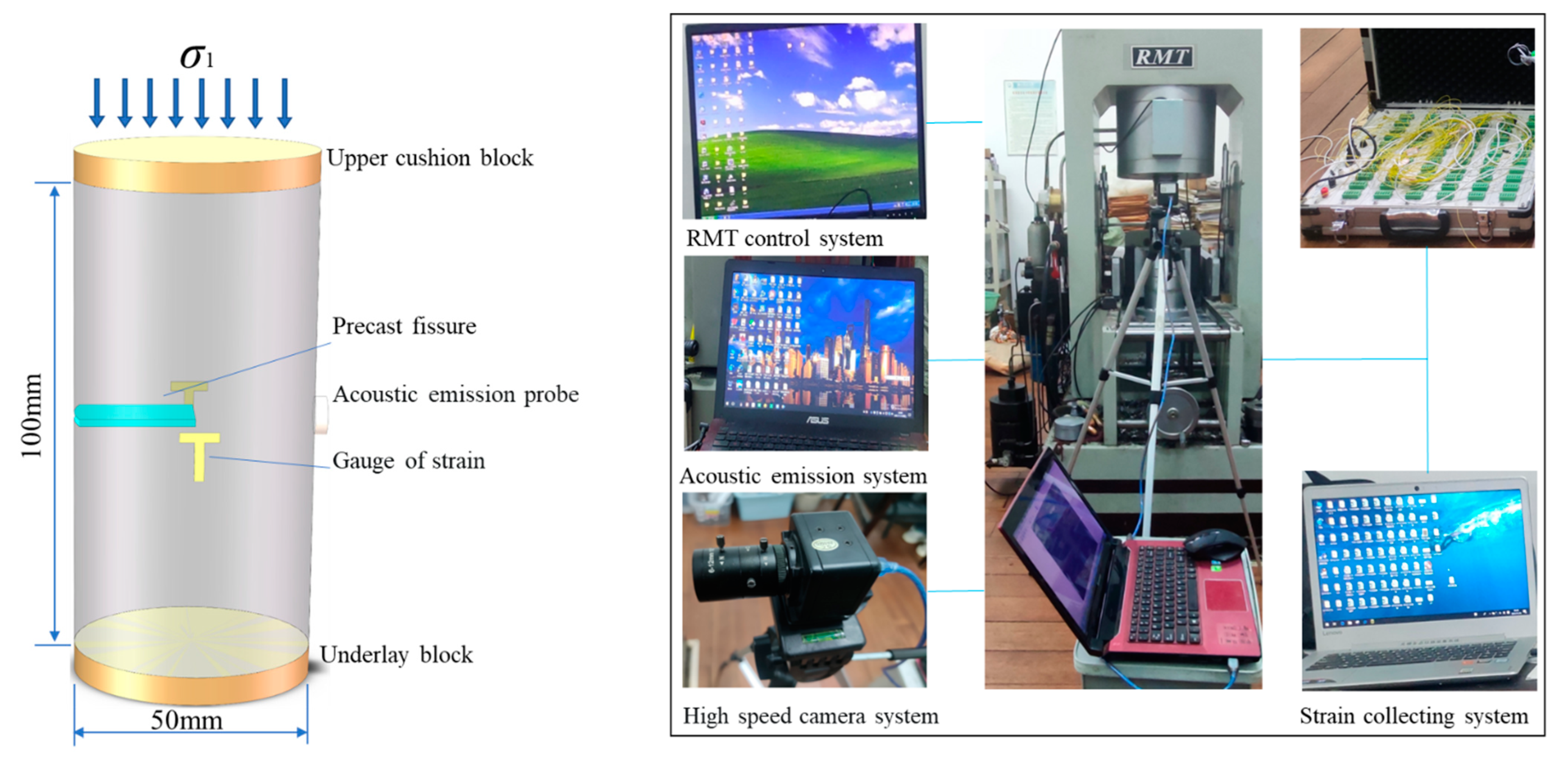

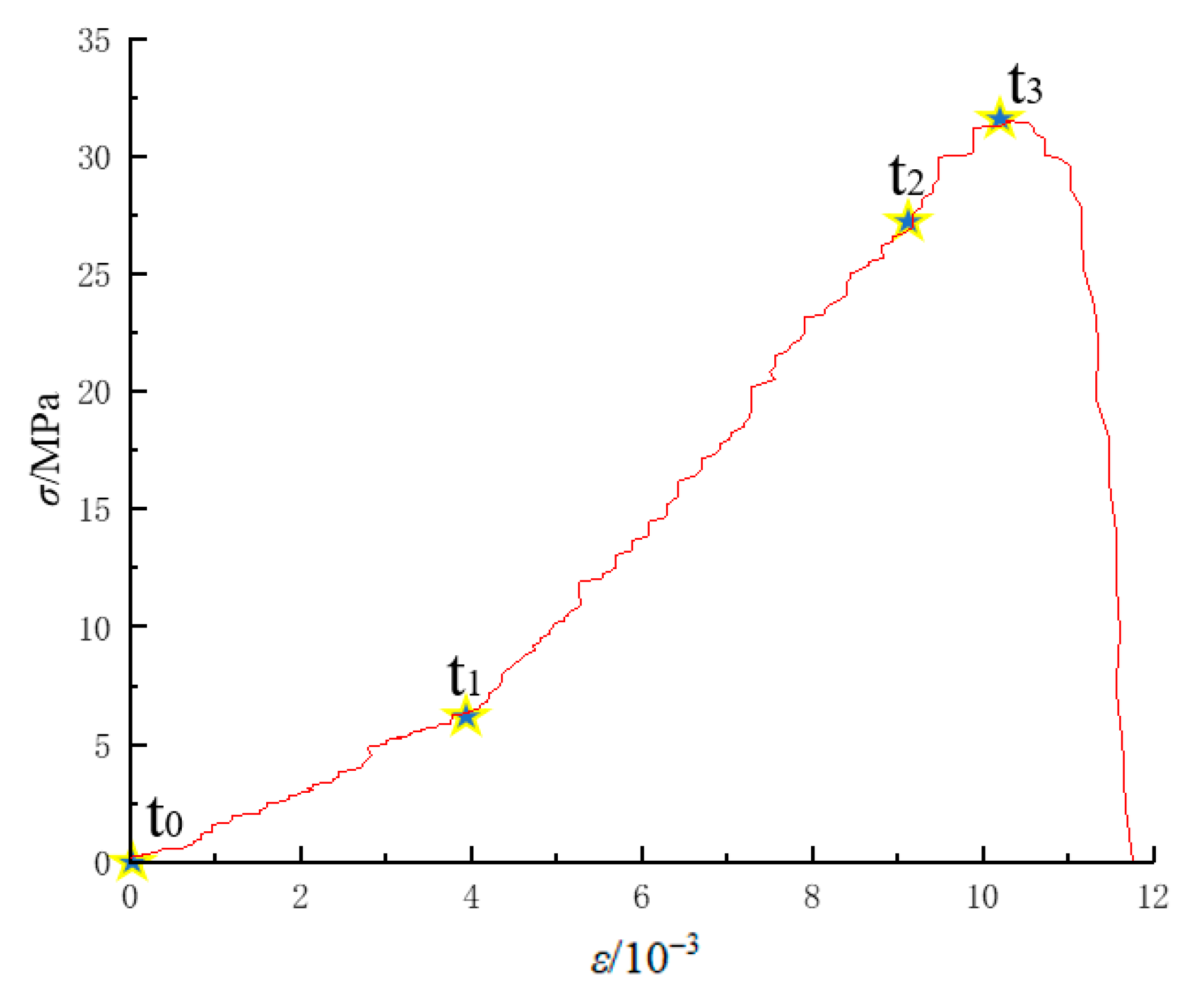
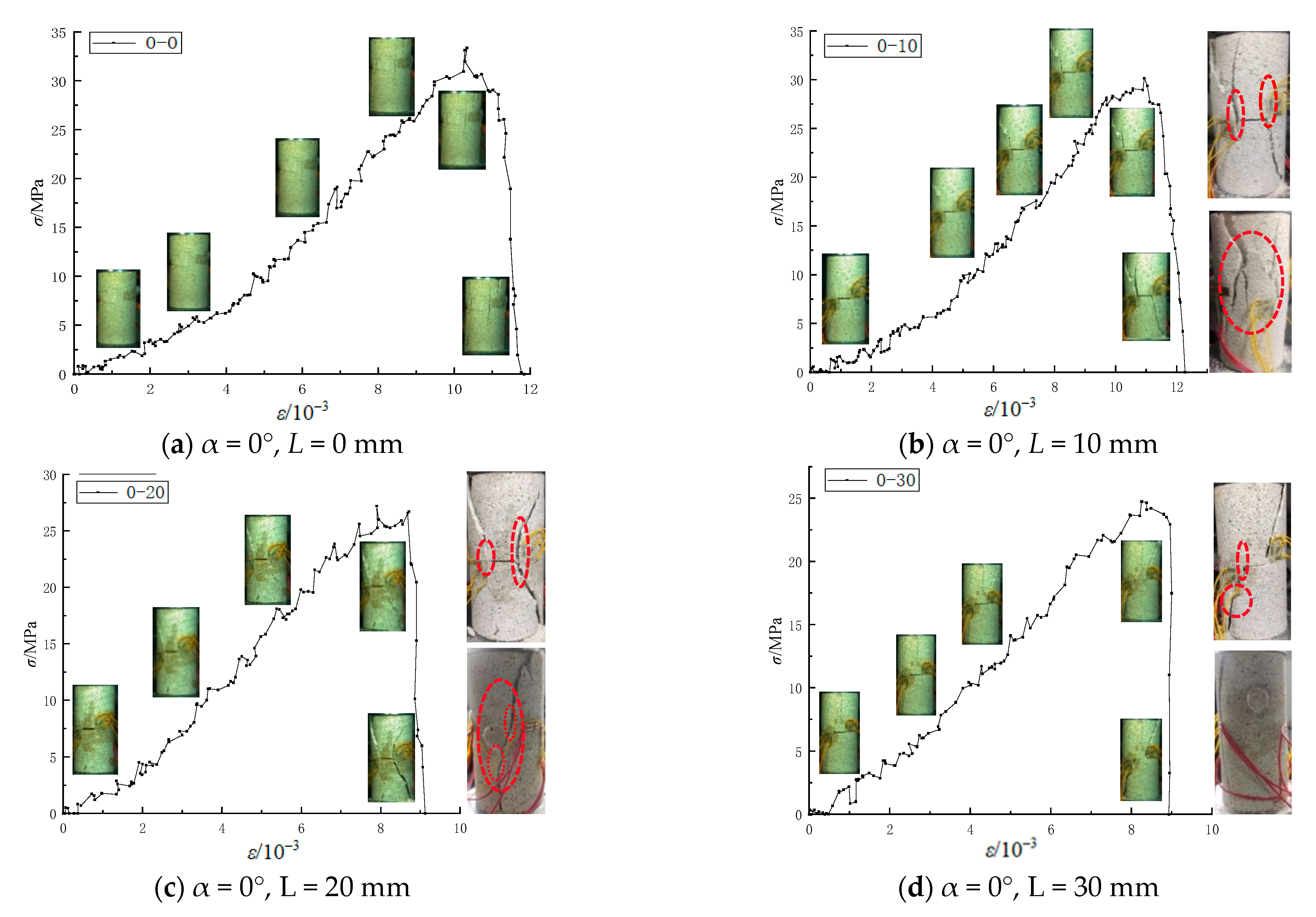
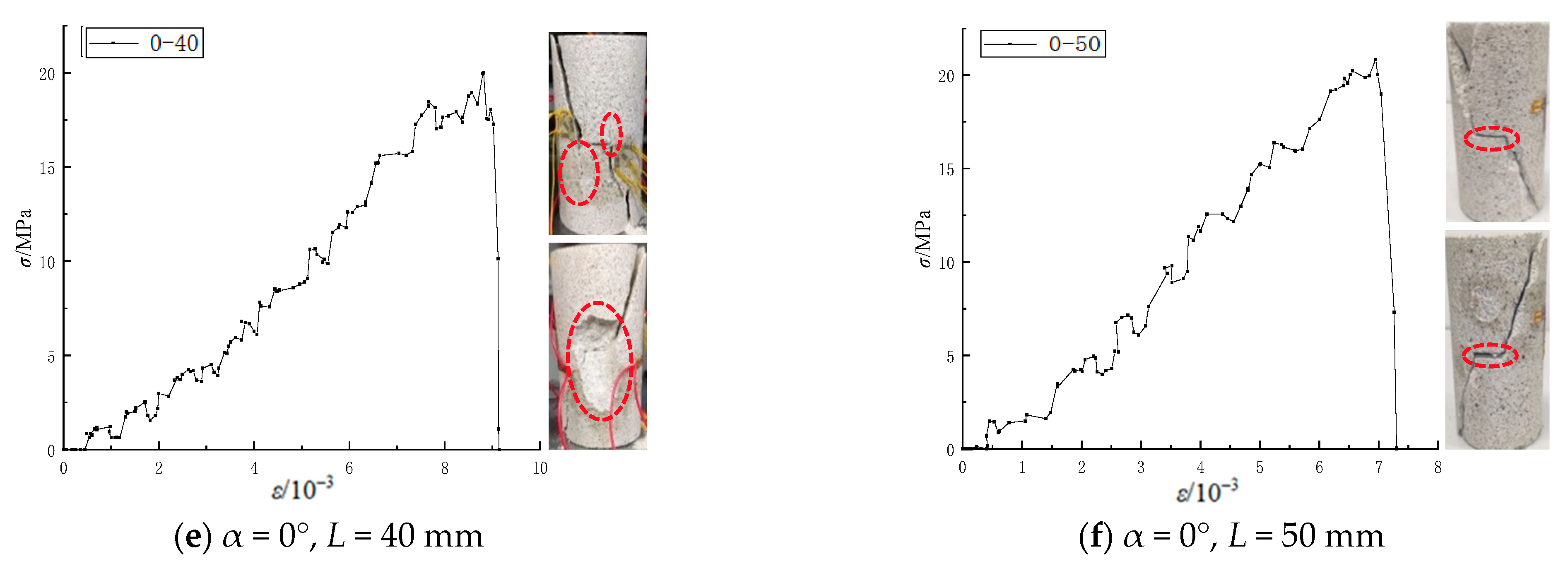
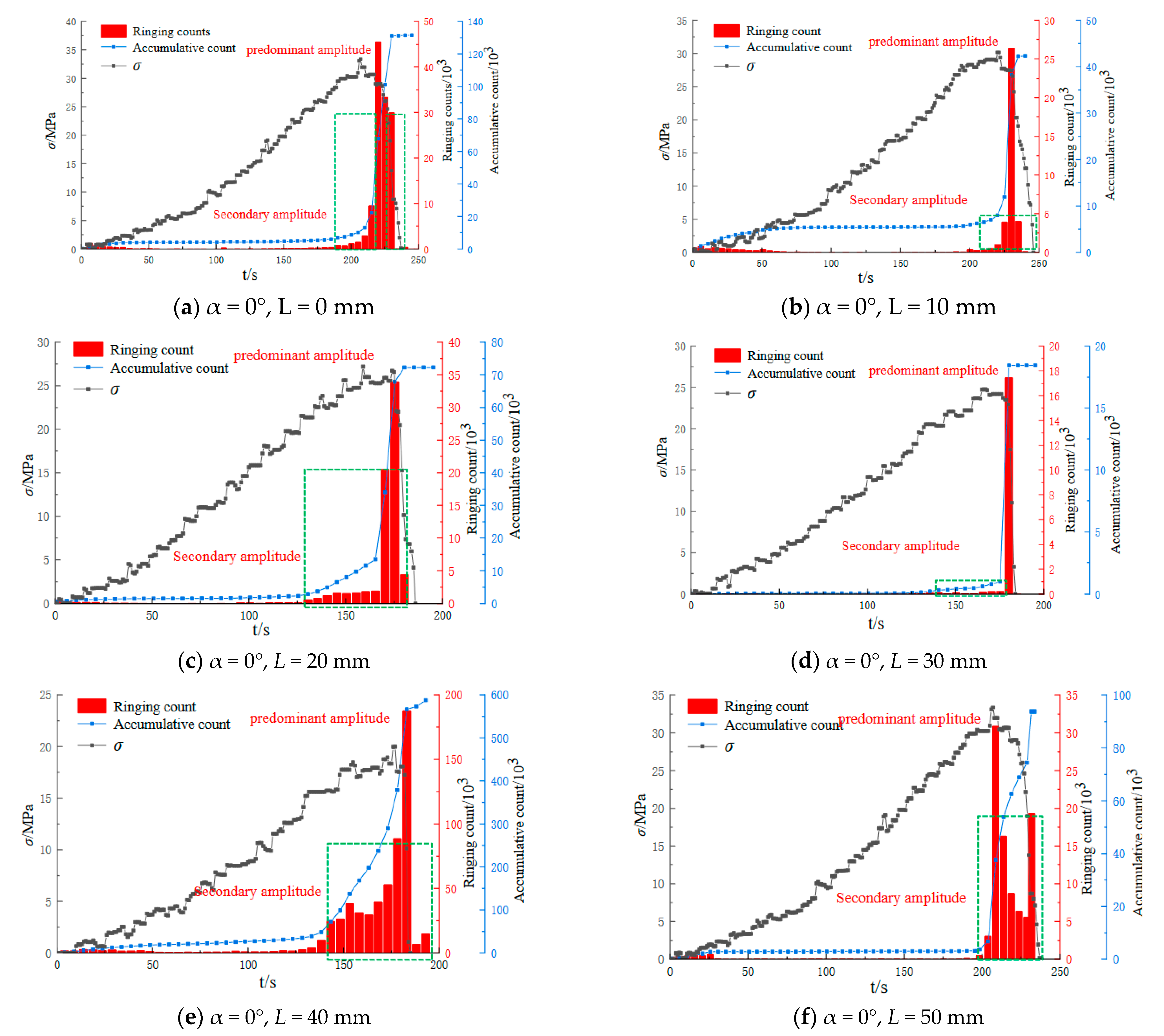
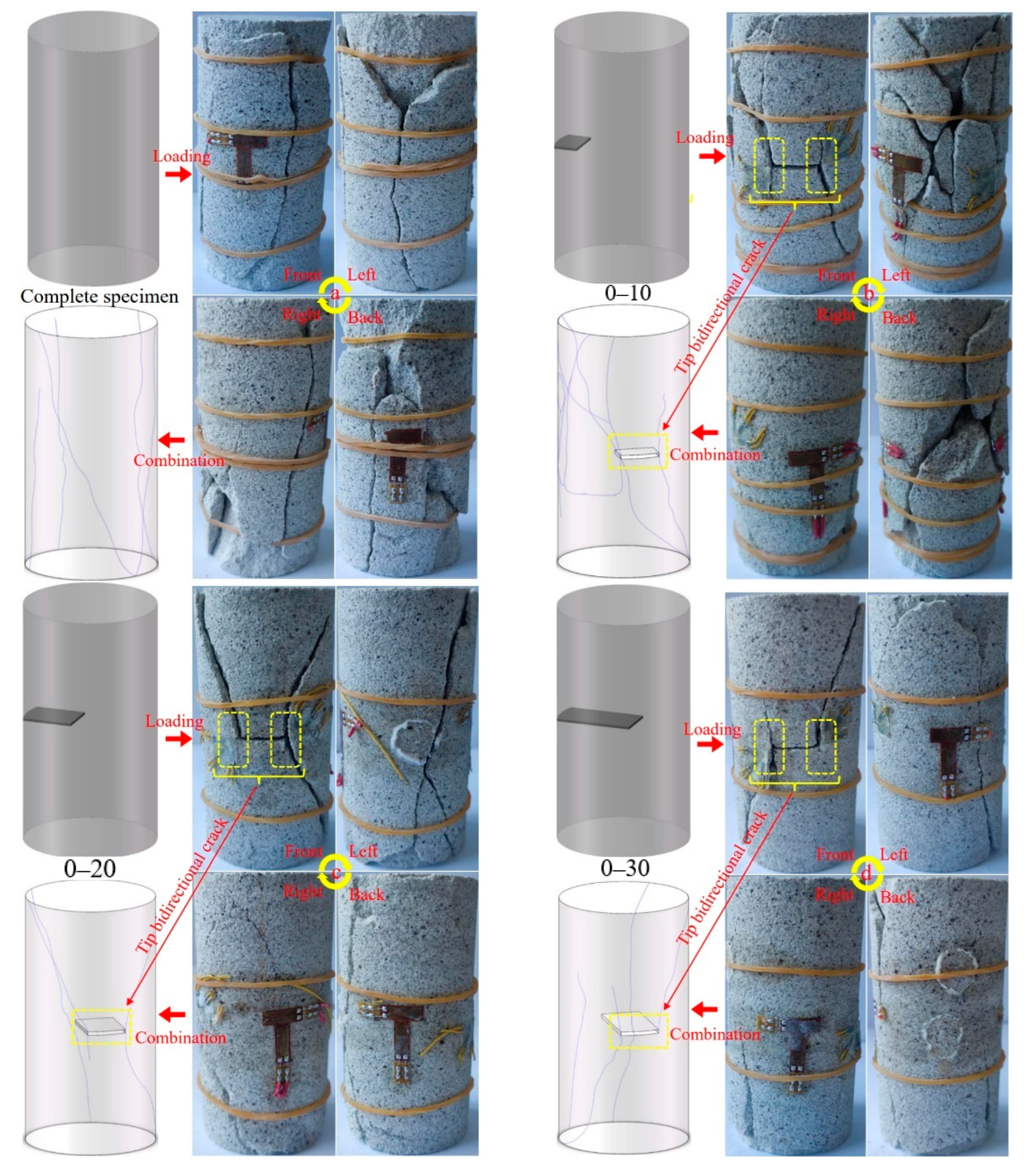
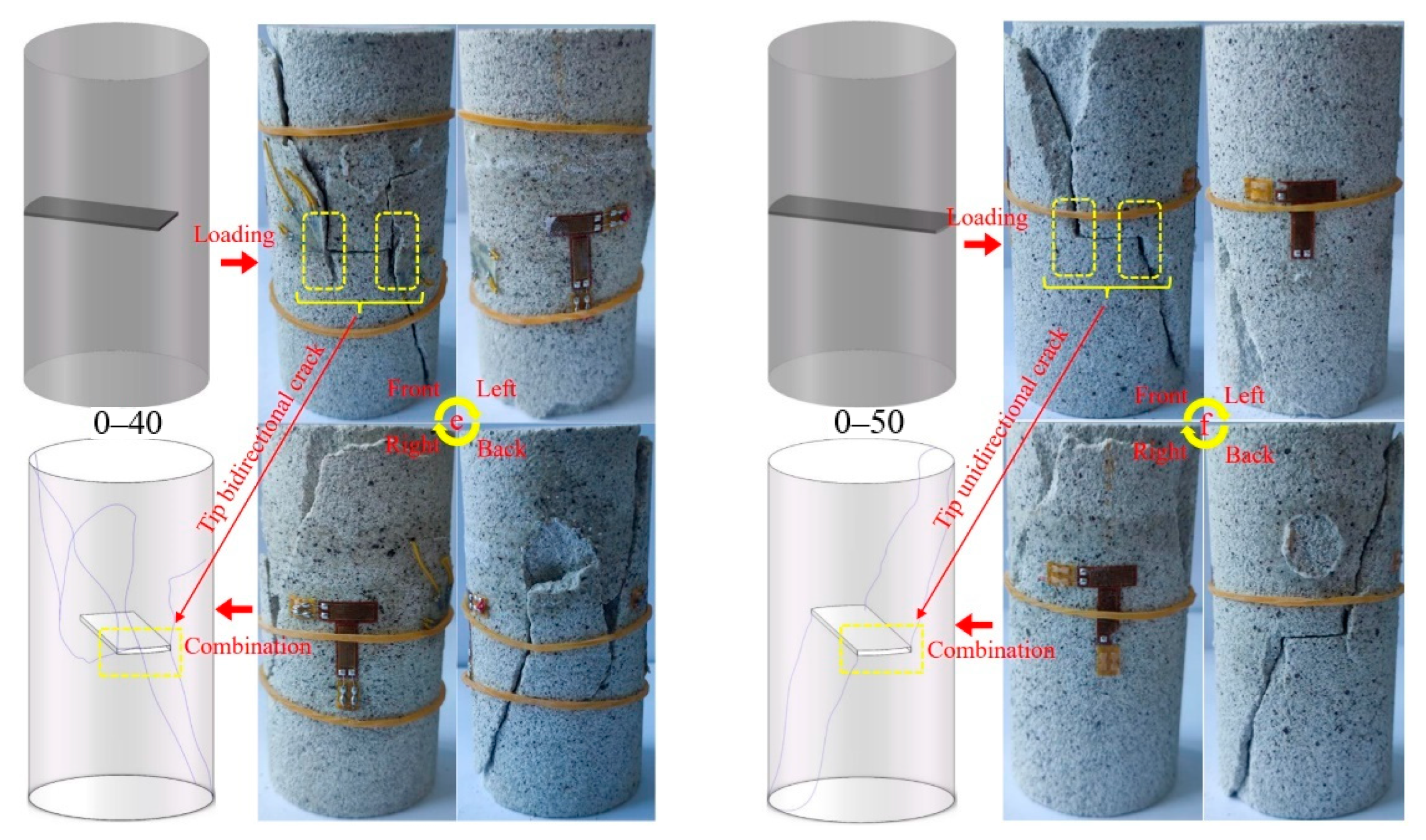
Disclaimer/Publisher’s Note: The statements, opinions and data contained in all publications are solely those of the individual author(s) and contributor(s) and not of MDPI and/or the editor(s). MDPI and/or the editor(s) disclaim responsibility for any injury to people or property resulting from any ideas, methods, instructions or products referred to in the content. |
© 2023 by the authors. Licensee MDPI, Basel, Switzerland. This article is an open access article distributed under the terms and conditions of the Creative Commons Attribution (CC BY) license (https://creativecommons.org/licenses/by/4.0/).
Share and Cite
Yu, W.; Guo, H.; Li, K.; Pan, B. Experimental Study on Uniaxial Compression Mechanics and Failure Characteristics of Non-Through Fractured Rock. Sustainability 2023, 15, 4968. https://doi.org/10.3390/su15064968
Yu W, Guo H, Li K, Pan B. Experimental Study on Uniaxial Compression Mechanics and Failure Characteristics of Non-Through Fractured Rock. Sustainability. 2023; 15(6):4968. https://doi.org/10.3390/su15064968
Chicago/Turabian StyleYu, Weijian, Hanxiao Guo, Ke Li, and Bao Pan. 2023. "Experimental Study on Uniaxial Compression Mechanics and Failure Characteristics of Non-Through Fractured Rock" Sustainability 15, no. 6: 4968. https://doi.org/10.3390/su15064968
APA StyleYu, W., Guo, H., Li, K., & Pan, B. (2023). Experimental Study on Uniaxial Compression Mechanics and Failure Characteristics of Non-Through Fractured Rock. Sustainability, 15(6), 4968. https://doi.org/10.3390/su15064968






